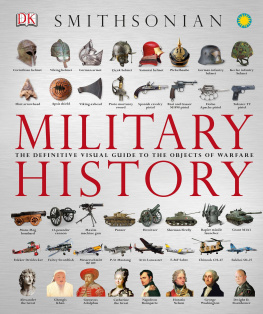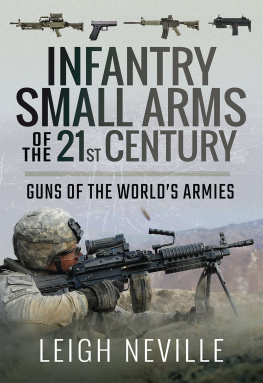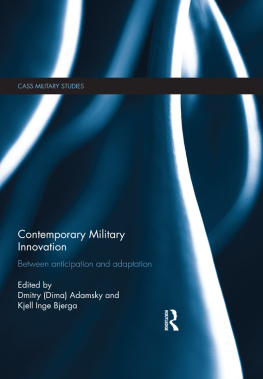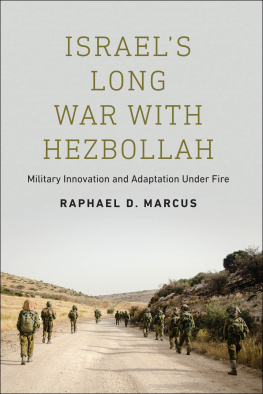WEAPON OF CHOICE
MATTHEW FORD
Weapon of Choice
Small Arms and the Culture of Military Innovation


Oxford University Press is a department of the University of Oxford. It furthers the Universitys objective of excellence in research, scholarship, and education by publishing worldwide.
Oxford New York Auckland Cape Town Dar es Salaam Hong Kong Karachi Kuala Lumpur Madrid Melbourne Mexico City Nairobi New Delhi Shanghai Taipei Toronto With offices in Argentina Austria Brazil Chile Czech Republic France Greece Guatemala Hungary Italy Japan Poland Portugal SingaporeSouth Korea Switzerland Thailand Turkey Ukraine Vietnam
Oxford is a registered trade mark of Oxford University Press in the UK and certain other countries.
Published in the United States of America by Oxford University Press Copyright Matthew Ford 2016
All rights reserved. No part of this publication may be reproduced, stored in a retrieval system, or transmitted, in any form or by any means, without the prior permission in writing of Oxford University Press, or as expressly permitted by law, by license, or under terms agreed withthe appropriate reproduction rights organization. Inquiries concerning reproduction outside the scope of the above should be sent to the Rights Department, Oxford University Press, at the address above.
You must not circulate this work in any other form and you must impose this same condition on any acquirer.
Library of Congress Cataloging-in-Publication Data is available Matthew Ford.
Weapon of Choice: Small Arms and the Culture of Military Innovation.
ISBN: 9780190623869
CONTENTS
I would like to offer my sincere thanks to everyone I have worked with in academia, at the Royal Armouries and at the UKs Ministry of Defence.
In particular, the following people have generously offered their time and expertise, for which I am extremely grateful: David Vassallo, David Parker, Pete Warden, Roy Brenton and Ian Passingham. I thank John Starling for helping me navigate and access the Ezell Archive at Cranfield University. I thoroughly enjoyed long discussions on small arms matters with David Benest, Tony Thornburn, Alex Watts and William F. Owen. I am particularly grateful to Major-general Colin Shortis, who helped me understand the decision-making on the adoption of SA80. Dr Dick Cave and Bob Evans have been instrumental in the latter parts of my research efforts, and I would like to thank them for encouraging me to work on more recent issues on small arms.
I would also like to thank a number of former RSAF employees and apprentices, including: Frank Vowles, Geoff Ellis, Paul Ellis, Ken Wilkes, Malcolm Slater, John Henshaw and Ray Tuthill. Each of them has been very generous with their time, helping me to understand what it was like to work at Enfield and offering me invaluable insights into the problems of large-scale small arms manufacturing.
In the early days of my research, there were a number of people who were crucial to making this project possible. All connected to the Royal Armouries, these people made research fun while keeping me true to my salt. I would particularly like to thank the last custodian of the MOD Pattern Room and now editor of Janes Infantry Weapons, Richard Jones. Apart from making me lug boxes of weapons from place to place while the National Firearms Centre was being set up, Richard gave me the benefit of his exhaustive firearms knowledge. Writing about small arms is made complicated by the unwilling ness of commentators to cite primary sources and the use of the Internet to propagate all sorts of myths. Richard helped me navigate my way through the pitfalls and kept me on the straight and narrow.
Apart from Richard, Jonathan Ferguson, curator of firearms at the National Firearms Centre, has regularly made time for lively and sometimes heated discussion. I would also like to thank my fellow honorary historical consultant colleagues at the Royal Armouries, Professor David Williams and David Penn. Both have generously given their time and offered detailed and invaluable observations. I would also like to thank the librarians at the Royal Armouries and especially Philip Abbot and Stuart Ivinson as well as a fellow regular reader in the library, Stuart Taylor. All of these people helped me stay focused on my research. Thanks go to them all.
A number of academic colleagues have also given their time to help me bring this project to fruition. To start, I would like to thank my PhD supervisor, Dr John Stone. Given the subject matter, most academics would not have been so generous, but John created an intellectual space that allowed me to take guns seriously. I am very grateful to him for this. Apart from John, I would also like to thank: Professor Anthony King, Professor John Buckley, Assistant Professor Matthew Barlow and Drs Tim Gale, Phillip Blood, Glenn Flint, Jeff Michaels, Andrew Hargreaves and Patrick Rose. I should also thank two very smart students, Jeremy Levett and Alexander Gould, who found a couple of things I did not have time to identify. Thanks also go to my colleagues at the University of Hull and the University of Sussex. Id especially like to single out Dr Anna Stavrianakis and Professor Jan Selby for taking the time to read and comment on my manuscript.
Lastly, Id like to thank my family and especially my mum, Gillie, and my daughter, Sarah; but most importantly, my wife Dr Sally Drayton.
Sally made this project. This book is dedicated to her.
| ABC | AmericaBritainCanada |
| A/CEAD | Assistant Chief Engineer Armament Design |
| ADE | Armament Design Establishment |
| BAR | Browning Automatic Rifle |
| BAOR | British Army of the Rhine |
| BBC | BritainBelgiumCanada |
| BJSM | British Joint Services Mission |
| BSA | Birmingham Small Arms Company |
| CEAD | Chief Engineer Armament Design |
| CGS | Chief of the General Staff |
| CIGS | Chief of the Imperial General Staff |
| CISA | Chief Inspector of Small Arms |
| CS(M) | Controller Supplies (Munitions) |
| DCIGS | Deputy Chief of the Imperial General Staff |
| DGofA | Director General of Artillery |
| DInf | Director of Infantry |
| DMT | Director of Military Training |
| DofA (SA) | Director of Artillery (Small Arms) |
| DoD | Department of Defense |
| DWD | Director of Weapons and Development |
| EM-1 | Experimental Model No. 1 |
| EM-2 | Experimental Model No. 2 |
| FAL | Fusil Automatique Lger |
| FARELF | Far East Land Forces |
| FN | Fabrique Nationale dArmes de Guerre: Belgian manufacturer |
| GPMG | General Purpose Machine Gun |
| GSR | General Staff Requirement |
| H&K | Heckler & Koch: German manufacturer |
| IGO | Inspector Government Ordnance |
| IRA | Irish Republican Army |
| IW | Individual Weapon |
| IFV | Infantry Fighting Vehicle |










